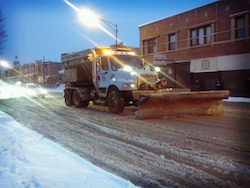SEJournal Online is the digital news magazine of the Society of Environmental Journalists. Learn more about SEJournal Online, including submission, subscription and advertising information.
TipSheet: Mining Road Salt Stories for Snow Season
The TipSheet does not want to bum you out, but … “Winter is coming.” Snow has already fallen, for instance, in Colorado and Minnesota.
So, if you are an environmental journalist, it may be wise to prepare your story about road salt now (so you can go skiing later).
Nobody wants the roads to be a mess. But people in the know (don’t get a big head, Chicagoans) know how to keep roads drivable without wrecking the environment. Here’s what you need to know.
Salt, as in sodium chloride, lowers the freezing point of water, melting ice — which is why states and municipalities use it on many winter roads.
But it also dissolves in water and runs off into streams, lakes, estuaries and sewage treatment plants. And the huge gouts of chloride that come after a melt affect the water, the land and the creatures trying to live in and on them.
Salt runoff does raise sodium chloride (“chloride”) levels in receiving waters. And it builds up. U.S. Geological Survey testing shows chloride levels continuing to rise.
If you have blood pressure problems, you do not want extra chloride in your water. It can cause plants along roadways to die back. If you walk your dog on salty roads, you learn it is not good for pets.
It affects not only surface waters, but also groundwater (where pollution lasts longer), making some wells unusable. Once chloride gets into soil, it does not automatically flush out, but often builds up, harming some plants and promoting invasion by others that are salt-tolerant.
There’s a lot more about environmental harm from road salt here, here and here.
Salt is not only solution for clearing roads
Detroit was one of the earliest cities to use road salt as a de-icer — in 1940 — which is hardly surprising since the city sits atop vast salt mines. Salt is used in many places today because it is cheap, plentiful and readily available.
 |
|
Chicago Public Works snow plow truck with a roll off salt spreader, in February 2013. Photo: Arvell Dorsey Jr./Flickr Creative Commons
|
Chicago, which knows from snow, struggles with the de-icer issue, according to a January 2017 piece by Patrick M. O'Connell in the Chicago Tribune. Some 350,000 tons of salt typically go onto the city’s streets in a year.
Meeting standards for chlorides in regional waterways may be hard, but remember that the failure by Mayor Michael Bilandic to clear streets in a 1979 blizzard won Jane Byrne the mayor’s office.
Salt is not the only de-icer. Alternatives include calcium chloride, calcium magnesium acetate, beet juice, urea and waste brines from cheese and pickle processing. Most of these have their own drawbacks as well.
Clear roads save lives, true. But that does not mean haphazardly dumping huge amounts of de-icing chemicals is the only important part of a winter road maintenance program.
Lots of other things are also important. Mechanical snow removal (plows and bucket loaders). Having enough of the right equipment. Having trained and motivated drivers. Stockpiling enough of the right materials. Starting early. Prioritizing. Predicting. And more.
Once the roads are plowed, salt and other de-icers can prevent dangerous slick ice. But good plowing can help minimize the need for de-icers. Sometimes brines or other de-icers are lightly applied ahead of a storm to keep snow from sticking and becoming ice.
Since prevention of slipping is the real goal, adding abrasives like sand to applied salt can reduce the total amount of salt needed. Once snow or slush has built up to certain depths, it is a waste of salt to apply it before roads are plowed.
If you see a salt truck paused for any length of time on a road with its spreader still running, you can expect to see a sizeable pile of (wasted) salt.
The U.S. Environmental Protection Agency sets standards for chlorides in both ambient water and drinking water. In drinking water, the secondary maximum contaminant level for chloride is 250 mg/l (that means it is mainly a nuisance that affects taste rather than health, and not mandatory).
By comparison, seawater is about 35,000 mg/l. For ambient water, EPA sets “criteria” describing concentrations compatible with various water uses, and the states regulate levels in particular water bodies. See tables here and here.
For the upside on road salt, you can go to the Salt Institute. Or you can ask your local auto body shop for an alternative view (hint: wash your car if it gets salty). There is a pretty good 2010 report on road salt from the Cary Institute of Ecosystem Studies.
If you need a new angle, you might ask how driverless cars will perform on slick winter roads, with or without salt.
* From the weekly news magazine SEJournal Online, Vol. 2, No. 41. Content from each new issue of SEJournal Online is available to the public via the SEJournal Online main page. Subscribe to the e-newsletter here. And see past issues of the SEJournal archived here.














 Advertisement
Advertisement 



